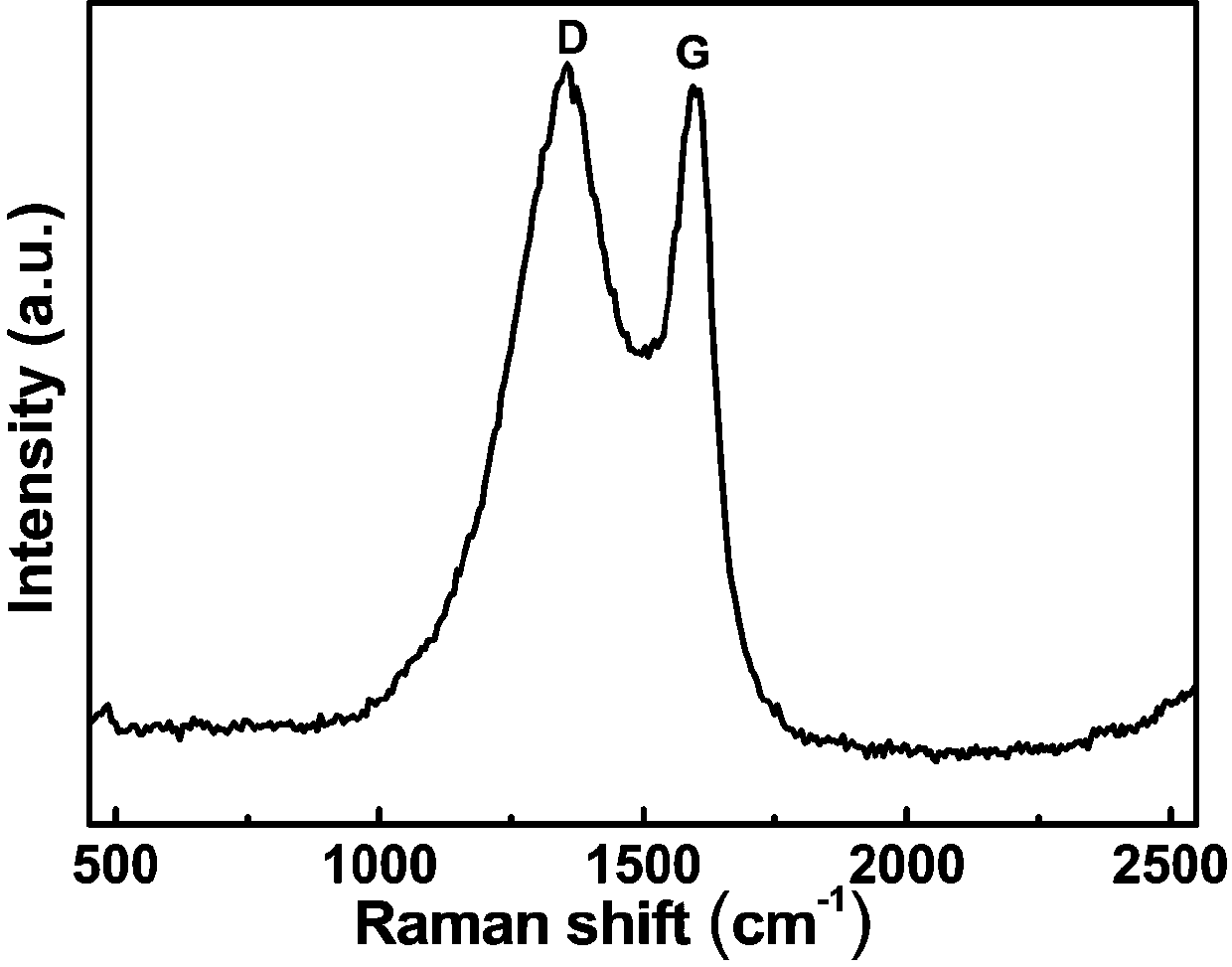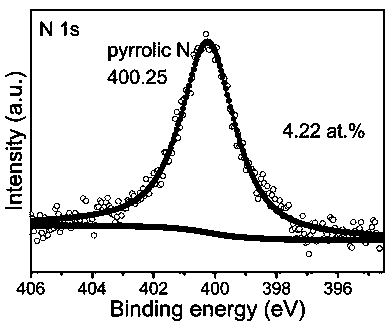Preparation method of amino phenolic resin-based pyrrole nitrogen-doped carbon electrode material
A technology of aminophenolic resin and nitrogen-doped carbon, applied in chemical instruments and methods, hybrid capacitor electrodes, carbon compounds, etc., can solve the problem of reducing the utilization efficiency of nitrogen-containing functional groups and the proportion of pseudocapacitive sites in nitrogen-doped carbon materials Decrease and other issues, to achieve the effect of high capacity, improved utilization, high pseudocapacitance performance
- Summary
- Abstract
- Description
- Claims
- Application Information
AI Technical Summary
Problems solved by technology
Method used
Image
Examples
Embodiment 1
[0041] A. Dissolve 0.1 g of 3-aminophenol, 0.1 g of 3-fluorophenol and 0.1 g of hexamethylenetetramine in 80 mL of distilled water, and stir at room temperature for 1 h until the solid sample is completely dissolved. Then, this solution was transferred to a 100 mL reaction vessel, at 160 o C for 4 hours, after natural cooling to room temperature, the product was washed with water to pH = 7, and dried to obtain a 3-aminophenol-3-fluorophenol-formaldehyde resin microsphere sample.
[0042] B, the obtained 3-aminophenol-3-fluorophenol-formaldehyde resin microsphere sample in step A is heated from room temperature to 500°C in a nitrogen atmosphere o C, keep warm for 4 hours. Samples were collected after natural cooling to room temperature.
[0043] C. Grind and mix the sample obtained in step B with the activator KOH at a mass ratio of 1 / 6, and then heat from room temperature to 500 °C in a nitrogen atmosphere. o C, keep warm for 8 hours. Naturally cooled to room temperature...
Embodiment 2
[0051] A. Dissolve 0.05 g of 3-aminophenol, 0.15 g of 3-fluorophenol and 0.1 g of hexamethylenetetramine into 80 mL of distilled water, and stir at room temperature for 1 hour until the solid sample is completely dissolved. Then, this solution was transferred to a 100 mL reaction vessel, at 160 o C for 4 hours, after naturally cooling to room temperature, the product was washed with water to pH = 7, and dried to obtain a 3-aminophenol-3-fluorophenol-formaldehyde resin microsphere sample.
[0052] B, the obtained 3-aminophenol-3-fluorophenol-formaldehyde resin microsphere sample in step A is heated from room temperature to 500°C in a nitrogen atmosphere o C, keep warm for 4 hours. Samples were collected after natural cooling to room temperature.
[0053] C. Grind and mix the sample obtained in step B with the activator KOH at a mass ratio of 1 / 6, and then heat from room temperature to 500 °C in a nitrogen atmosphere. o C, keep warm for 8 hours. Naturally cooled to room te...
Embodiment 3
[0057] A. Dissolve 0.025 g of 3-aminophenol, 0.175 g of 3-fluorophenol and 0.1 g of hexamethylenetetramine in 80 mL of distilled water, and stir at room temperature for 1 h until the solid sample is completely dissolved. Then, this solution was transferred to a 100 mL reaction vessel, at 160 o C for 4 hours, after naturally cooling to room temperature, the product was washed with water to pH = 7, and dried to obtain a 3-aminophenol-3-fluorophenol-formaldehyde resin microsphere sample.
[0058] B, the obtained 3-aminophenol-3-fluorophenol-formaldehyde resin microsphere sample in step A is heated from room temperature to 500°C in a nitrogen atmosphere o C, keep warm for 4 hours. Samples were collected after natural cooling to room temperature.
[0059] C. Grind and mix the sample obtained in step B with the activator KOH at a mass ratio of 1 / 6, and then heat from room temperature to 500 °C in a nitrogen atmosphere. o C, keep warm for 8 hours. Naturally cooled to room tempe...
PUM
| Property | Measurement | Unit |
|---|---|---|
| Pore diameter | aaaaa | aaaaa |
| Current density | aaaaa | aaaaa |
| Specific capacitance | aaaaa | aaaaa |
Abstract
Description
Claims
Application Information
 Login to view more
Login to view more - R&D Engineer
- R&D Manager
- IP Professional
- Industry Leading Data Capabilities
- Powerful AI technology
- Patent DNA Extraction
Browse by: Latest US Patents, China's latest patents, Technical Efficacy Thesaurus, Application Domain, Technology Topic.
© 2024 PatSnap. All rights reserved.Legal|Privacy policy|Modern Slavery Act Transparency Statement|Sitemap



